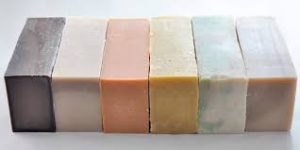This particular olive, coconut, palm & less water recipe came about because of the Blackberry and Orange soap recipe. The finished bars were a little soft – usable, but a little softer compared to the other bars. It was concluded this was because of the huge amount of orange essential oil needed to obtain and decent lasting scent. The solution was to add a palm or palm kernel oil PLUS add a little less water, but not too much. The palm oils help to make a harder bar and the less water due to the more liquid of the orange essential oil. And this worked perfectly!

The only oil to not use in over 50% of total oils, is canola oil. Although canola oil is the oil of every single restaurant on the planet, it isn’t the best for soap, but only because of the reaction to the lye and the oxidation of the oils. This means that a canola oil-based soap will start getting brown discolored spots on the soap bars. This is too bad really, because the cheaper cost of the canola helps keep the price of your final product lower. more about the type of oils and the pros and cons of each can be found on this basic soap-making recipe page.
This makes about 25 4-ounce bars, so dividing it in half to make test batches would work well.
Olive, coconut, palm & less water:
- 51.2 oz Olive oil blend (can use 50% canola oil)
- 6.2 oz coconut oil
- 6.2 oz palm oil
- 19.0 oz water
- 8.6 oz lye crystals
- for a total soap base of 85.0 oz
Here’s the Blackberry Orange soap recipe, you’ll see the need for the olive, coconut, palm & less water recipe due to the highest volume of essential oils.
#handmadesoap #naturalsoap #makingsoapnaturally #soapmaking #soapmaking #soaps #artisansoap #bathandbody #cpsoap #coldprocesssoap #etsy #soapbase #soapcrafter #soapmaker #soaping #soapcrafting #soaphandmade #soap #giftidea #christmas #barsoap #handmadesoap #natural #organic #skincare #coldprocess #soapsupplies #soaprecipes
© 2023, Tes. All rights reserved.